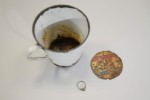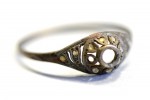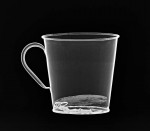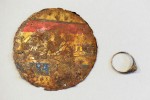 Staff at the Auschwitz Museum have discovered one person’s cherished treasures hidden under the false bottom of a mug for more than 70 years. The mug is one of more than 12,000 pieces of enameled kitchenware — pots, bowls, kettles, cups — in the museum’s collection, the quotidian things people brought with them when being deported in the desperate hope that they would have some kind of normalcy. Nazi officials encouraged this belief.
Staff at the Auschwitz Museum have discovered one person’s cherished treasures hidden under the false bottom of a mug for more than 70 years. The mug is one of more than 12,000 pieces of enameled kitchenware — pots, bowls, kettles, cups — in the museum’s collection, the quotidian things people brought with them when being deported in the desperate hope that they would have some kind of normalcy. Nazi officials encouraged this belief.
“The Germans incessantly lied to the Jews deported for extermination. They were told about resettlement, work and life in a different location. They allowed the victims take with them little luggage. In this way, the Germans were confident that in the luggage – including clothes and items needed for life – they would find the last valuables of the deported families,” said the Director of the Auschwitz-Birkenau State Museum Dr. Piotr M. A. Cywiński.
“The hiding of valuable items – repeatedly mentioned in the accounts of survivors, and which was the reason for ripping and careful search of clothes and suitcases in the warehouse for looted items – so-called ‘Kanada’ – proves on the one hand to the awareness of the victims as to the robbery nature of the deportation, but on the other hand it shows that the Jewish families constantly had a ray of hope that these items will be required for their existence” stressed director Cywiński.
 The owner of the mug defeated this vile scheme by creating a false bottom and hiding precious valuables in the space: a woman’s gold ring with gemstones and a gold chain necklace, coiled and wrapped in canvas. Both pieces bear the mark of a head of a knight with the number three on his right side, a symbol in common use in Poland between 1921 an 1931 for 583 gold, which means the gold content is 583 parts per thousand, or just a hair under 14 karats. While the ring is missing its central gemstone and some of the smaller ones, several of them remain snug in their settings.
The owner of the mug defeated this vile scheme by creating a false bottom and hiding precious valuables in the space: a woman’s gold ring with gemstones and a gold chain necklace, coiled and wrapped in canvas. Both pieces bear the mark of a head of a knight with the number three on his right side, a symbol in common use in Poland between 1921 an 1931 for 583 gold, which means the gold content is 583 parts per thousand, or just a hair under 14 karats. While the ring is missing its central gemstone and some of the smaller ones, several of them remain snug in their settings.
 The hidden treasure was discovered during routine maintenance work on the enameled kitchenware in the exhibition. Curators noticed that what had once seemed like the bottom of the mug was in fact pulling up, revealing a secret compartment. It kept its cache secure for more than 70 years before the metal gradually degraded, lifting the false bottom and separating it from the mug. Museum staff X-rayed the mug to see what the false bottom was hiding. X-ray fluorescence then confirmed the presence of copper, gold and silver. Only then did conservators carefully remove the bottom to examine the precious contents.
The hidden treasure was discovered during routine maintenance work on the enameled kitchenware in the exhibition. Curators noticed that what had once seemed like the bottom of the mug was in fact pulling up, revealing a secret compartment. It kept its cache secure for more than 70 years before the metal gradually degraded, lifting the false bottom and separating it from the mug. Museum staff X-rayed the mug to see what the false bottom was hiding. X-ray fluorescence then confirmed the presence of copper, gold and silver. Only then did conservators carefully remove the bottom to examine the precious contents.
 Through the rust you can make out a brand name and colors on the false bottom. The edges are rough, which is at least in part due to corrosion, but I think the mug’s owners cut out a circle from a discarded tin of some kind and then somehow fitted it into the mug so adeptly that it fooled the Nazis, the crews of people they had tearing apart people’s belongings looking for valuables and from 1947 to 2016, the staff of the Auschwitz Museum.
Through the rust you can make out a brand name and colors on the false bottom. The edges are rough, which is at least in part due to corrosion, but I think the mug’s owners cut out a circle from a discarded tin of some kind and then somehow fitted it into the mug so adeptly that it fooled the Nazis, the crews of people they had tearing apart people’s belongings looking for valuables and from 1947 to 2016, the staff of the Auschwitz Museum.
 As with so many thousands of objects recovered from Auschwitz, there are no identifying marks that might help historians give credit to the ingenious person or people who so effectively hid these jewels from the Nazis and everyone else for seven decades. The mug and jewelry will kept in the museum in a manner that reflects how they were used so cleverly by desperate but hopeful people, mute but eloquent witnesses to the experience of Jews deported to the extermination camp.
As with so many thousands of objects recovered from Auschwitz, there are no identifying marks that might help historians give credit to the ingenious person or people who so effectively hid these jewels from the Nazis and everyone else for seven decades. The mug and jewelry will kept in the museum in a manner that reflects how they were used so cleverly by desperate but hopeful people, mute but eloquent witnesses to the experience of Jews deported to the extermination camp.
I would think that the chain was wrapped in canvas to prevent it making a tell tale noise when the mug was handled.
Thank you for this article, Livius. Your discussion has so much more clarity than the version on Bing yesterday.
Such tragedies these people suffered and how brave they were
At the Holocaust Museum in Washington, D.C., a gigantic pile of shoes – men, women, childrens footwear, were being cleaned for the preservation and display. Most were fashioned from aged, worn and terribly soiled leather and needed attention. Surprisingly, an historian found a forgotten / or simply never discovered note. It had been shoved into the toe of a shoe. It detailed the owner’s name, hometown, etc… The person yearned for their remaining kith to find him or at least know what had happened.
Simon Wiesenthal authored a best-seller detailing how the Nazi had an odd concept about the Jew’s ‘stolen goods.’ Post-WWII, storage rooms were discovered with unbelieveable collections – a gigantic mound of kitchenwares or thousands of pocketbooks, etc… Why? It was as though the Nazi felt these people were like space aliens -therefore, their belongings needed to be kept apart. It was an insane time…
One breath-taking tale Wiesenthal witnessed was about a young survivor. He was orphaned, homeless and somewhat lost. He tagged along just to help Wiesenthal’s team of researchers. The group broke into a Nazi warehouse to search the contents. The lad casually picked up an edition from an unbelieveably vast mountain of books. He opened it, discovering a note; Upon reading this handwritten plea, the youth fainted. The book had been his Mother’s. Quickly, she had scribbled a message that the Nazi troops were at their threshold. The frightened woman prayed for a miracle. The parent needed this message to somehow reach her son so he would know the fate of his family.
The false bottom was likely cut out of a chocolate box. The writing on it reads like “Goplana” which is a chocolate confectionery brand, established in 1912 and still on the market in Poland today.
I find these personal items deeply compelling.
Oh,my..one cannot help think that this was “not by chance”..This whole story is just so very sad..and we humans seem to keep on doing these horrible things.